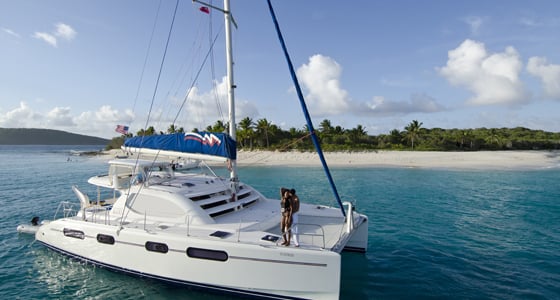Learn more about our Leopard 46 model in this review written by one of our expert agents who lives in the BVI and works at our largest base in the world.
I will start out by mentioning that the 46 is probably my pick of all the Leopards so far. I live in the BVI and work at the company's largest base in the world, this has allowed me to get an up close and intimate look at all of our models including the Leopard 46. Overall I find being surrounded by all the other manufacturers and models that the 45ft ish size range of cat is right in the sweet spot and probably all you will ever need for cruising. The smaller 40ft cats are excellent if you have a small budget or are a cruising couple, but the 46 is still easy to handle with just 2 if you need more space for the family and friends.
Hull #1 of the model was built in late 2006. While there were a few updates in the first couple of years, there was no major structural changes up to the last boats that came off the line in late 2011. One weak point with some of the early hulls was the davits. The original design was changed to a chunkier version of the original and replaced under warranty. The new davits increased the load capacity and stopped some of the issues of cracking and failure of the original design. They use a single speed 14 Lewmar winch on each for raising and lowering the tender. The bow end of the tender raises fine, but the outboard end does make it a little more work. To make life easier an option that works instead of changing winches is to change and add extra pulleys to increase the purchase on the lift lines.
Originally Leopard Catamarans came with Volvo engines, but in 2008 Leopard switched over to Yanmar’s going forward. The 4JH5E provided the right amount of reliable power to cruise at about 7.5 to 8 knots at 2500rpm. One common comment was that the engines had been put in back to front. This was on purpose and worked well with the saildrive forward of the engine. This meant the propeller was forward of the rudder which benefits from its wash and increase to steerage. On a monohull this characteristic is crucial when it comes to maneuvering and while the twin screws on a cat make it not so necessary it certainly helps when the going gets tight. Another plus is the front of the engine is more in the center of the engine bay which makes access to belts, impeller, etc for easier maintenance.

The biggest change update was in 2008 was to the helm area and its hardtop. Steps from the cockpit directly to the helm were designed in to allow easier access than having to walk around and access from the sidedeck. This also meant the helm hardtop became a little larger to cover the area. This was the only real design change over the years and a nice benefit. By 2009 solar power was starting to come in and you will start to see a couple of small flexible panels fitted on the helm hardtop. For boats in the fleet this was as much solar as they ever had. For private boats there were options for more with plenty of space on the main hardtop. Most boats on the market will have had retro fitted panels of some design the owners will have decided on for their usage. There is good access into the hardtop for wiring and mounting. Often you will see setups using the davits and the aft deck/back of hardtop used to keep the hardtop clear of panels and incorporate a wind generator as desired.
The helm itself is a great layout and great visibility all around, but not so open and exposed that if the weathers not pleasant you cannot zip up the enclosure easily and be comfortable. For docking all four corners are on view. The port aft is a little obscured, but I find it easy enough to bend your head down a bit and look under the hardtop if need be. Instruments, controls and winches are well placed for ease of use. On fleet boats neither of the 2 main primary winches were electric. Certainly upgrading and making the starboard winch electric makes life easier and possible to lead all lines to it as needed. Also, if you want to run the main halyard to the helm then needed. Otherwise all the halyards and reefing lines are up at the front of the mast and 2 winches to manage them. That mainsail is quite big and really needs 2 strong individuals to haul it up with a minimal amount of winching left to finish tightening. To make life easier I will often use the windlass and if single handed. The angle to it for the halyard works well so you just ease the gypsy off so it freewheels to use to haul up. Many people I have met have bought and use a powered winch handle instead. I am also a fan of the old style traveler set up for the mainsail worked by a small winch and clutches just behind the helm seat. It keeps it separate out of the way of everything else going on with lines and find makes trimming more adjustable and easier.
With the sails up she performs very well and easy to handle. Quite agile and quick for a larger cat with her Morelli & Melvin design influences. She does not need too much wind either to get up and going and slips along well in lighter breezes. Solid and stable enough though that when things get a bit rougher she is happy to keep charging along and not get uncomfortable. Coming from a racing background I have always enjoyed a bit more speed in the equation and over a passage with good trim can really shorten the hours to the next port of call.

Interior wise she is very comfortable and large enough to accommodate 4 cabins with ensuite heads or a very spacious owner’s arrangement on the starboard side. As most built went into the charter fleets there were very few owners versions ever built. The cabin space in the hulls is good and the ensuite heads have a separate shower area and screen. The steps along the companionways in each hull do seem a stumbling point compared to the newer models with their flush one level floors throughout. However, hidden under here are air conditioning units and pumps which are nice and accessible and easy to work on when need to do something. In fact most systems and access to work on things onboard is good. With most boats built going into the fleets ease of maintenance has always been a big point when designing Leopards.
There is room for 4 of the 4D type house batteries in the port bow locker along with the generator. Starboard side has the large water tanks and there was an option for extra water tanks which placed them under the forward cabin berths. Most will not have had them and typically adding a watermaker a preferred option. Storage is excellent both inside and out and lots of room for cruising gear. There is a crew cabin with head in the starboard bow and bunk on the port side. These spaces rarely actually get used for crew but make ideal storage spaces otherwise. Layouts have changed with each model generation for the galley/salon, but on the 46 it is ideal I find with plenty of usable/workable spaces. Visibility out is great, although slightly obstructed forward by the steps up to the coach-roof/hardtop. These also work as shades to the large front windows and keeping the direct sun out. There also one of the good spots to sit and take in the view while underway. Those large windows forward and to the side do have a bit of a weakness though and tendency to need rebidding at some point.
My favorite spot on the boat though is the aft deck seat between the davits. Not only a great place to be at different times of the day, it also hinges down to make a small swim up platform just above the water. Something not incorporated in any other Leopard so far and a unique feature I like. With that and everything else it rounds up a well balanced package which is hard to beat in this size range and price point.


